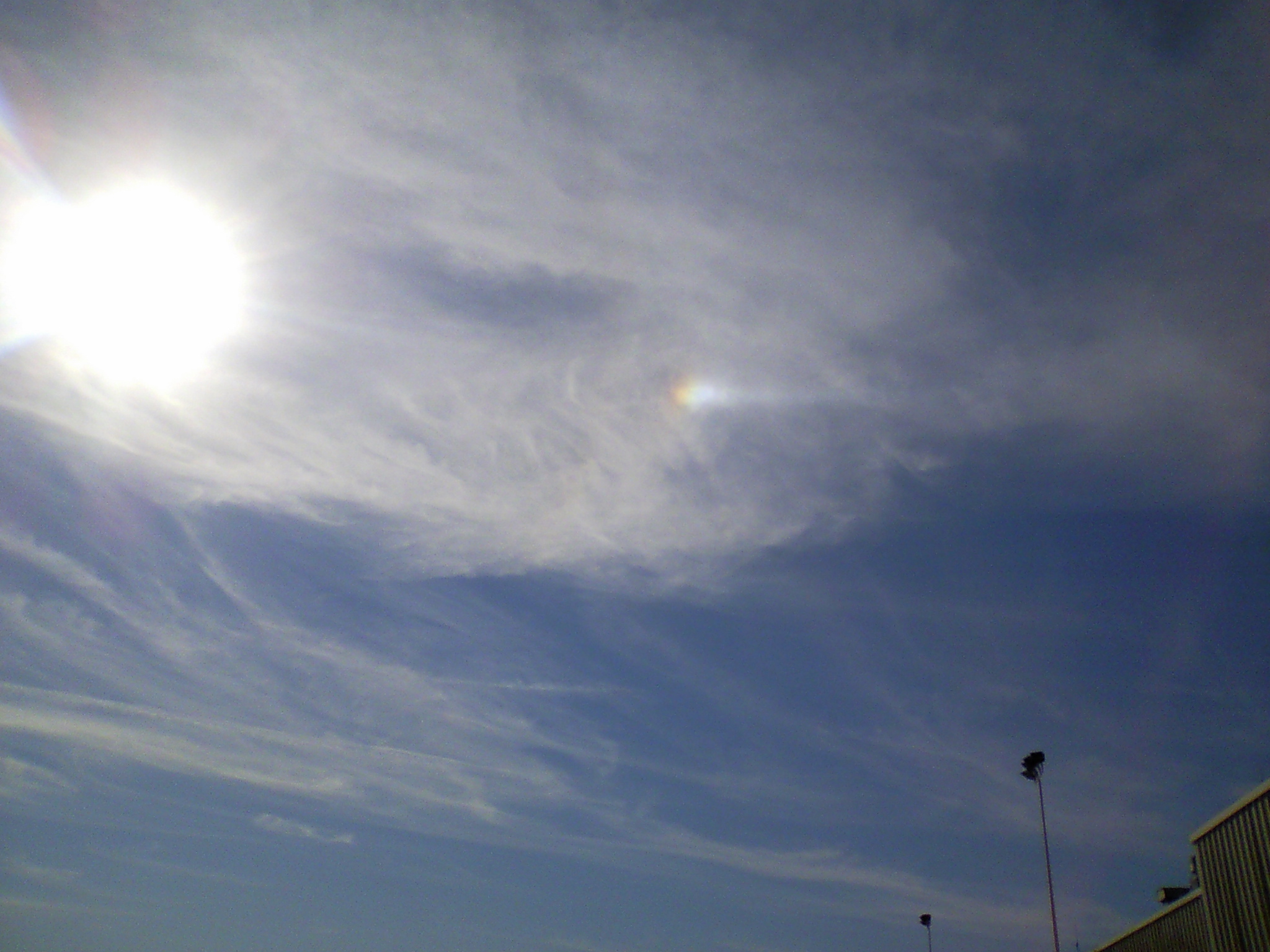
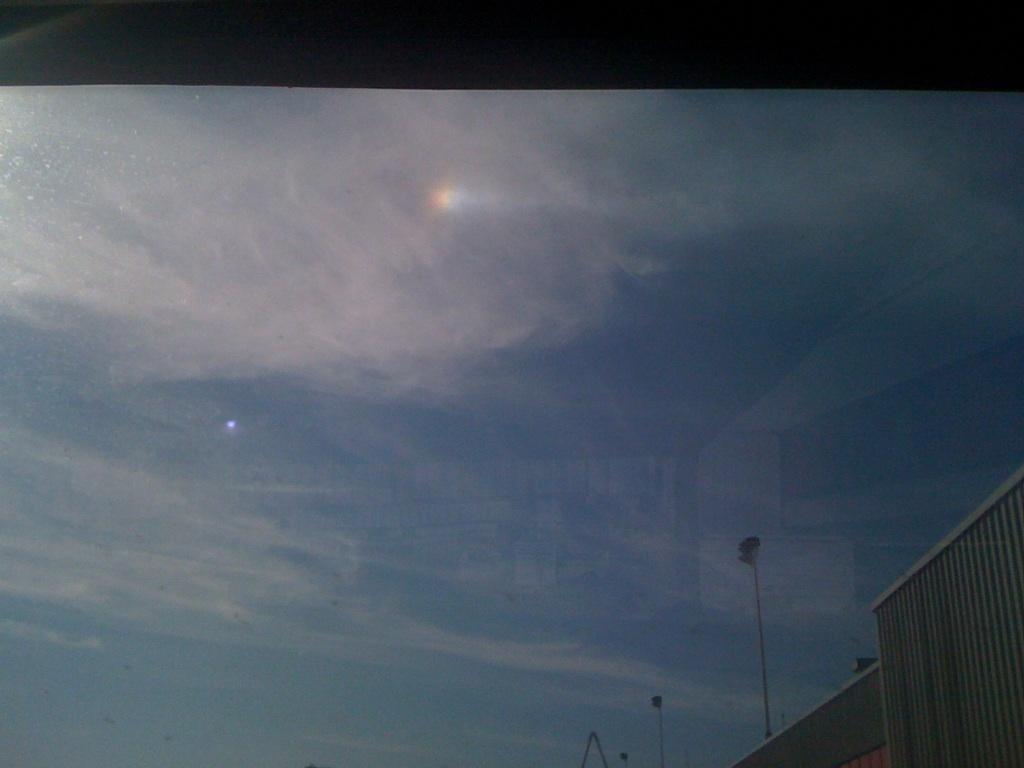
Summary. An aerial anomaly consisting of a bright light in the clouds appeared over Hartsfield Airport in Atlanta, Georgia, on November 1, 2010. Two photographs of the anomaly were available for analysis. Enhancement of the images revealed a saucer-shaped craft beside the light. The light itself seemed to be from the afternoon sun focused by a toroidal region of space adjacent to the craft. The white light passing through this space also separated into the colors of the rainbow. This confirms an earlier observation that a saucer craft is accompanied by a toroidal volume of space that has an altered index of refraction.
The two photographs in Figure 1, the subject of this article, were provided by Chris Malcheski of Atlanta, Georgia. PhotoA was taken by an acquaintance employed as a baggage handler supervisor at Hartsfield Airport, Atlanta. PhotoB was taken by that person's coworker. Both photos show an anomalous bright light in the clouds, mostly white but edged with additional colors.
 |
 |
| PhotoA. 2048x1536 camera image | PhotoB. 1024x736 cell phone image |
| Figure 1. Photographs of an anomaly over Hartsfield Airport, Atlanta | |
The photographs were taken while the workers were outside performing their duties on the tarmac. PhotoA was taken with a Casio camera and PhotoB was taken with a cell phone camera. PhotoB shows reflections of what appears to be the exterior of a building, perhaps a parking garage. Closer inspection reveals what may be the track of a wiper blade near the upper left corner of the image. That track, as well as specks of dirt above it in the upper left corner, suggest that the photo was taken through the windshield of a vehicle. The small light in the center-left of the image is likely also a reflection from an external light source. PhotoA shows no evidence of dirt or reflections and, hence, does not appear to have been taken through a window of the vehicle.
The EXIF data for PhotoA can be seen here. It was not available for PhotoB.
In Figure 2, the light objects in each photo are shown matched in size and position under the assumption that the clouds did not move during the interval between photos. The size was visually matched by enlarging PhotoB so that a selected cloud feature was the same size as measured in PhotoA using a ruler. The object was then cropped from each photo by selecting the same area located using corresponding cloud features. Since the matching procedure was independent of the anomalous object's size and position, we can see that the light moved relative to the clouds during the interval between photos. In PhotoA, the object is further to the left than in PhotoB.
Enhancement of the images using the image equalization tool available from Mehdi can bring out detail in the clouds that is normally barely visible. Sometimes, the procedure can reveal geometric structures that appear remarkably like artificial objects (for example, see here and here). The tool offers non-linear control to compensate for large differences in brightness over the image. The second row of Figure 2 shows the equalized perceptual luminosity of the images. According to the Medhi documentation, the luminosity is modified while preserving the hue and saturation of the image. In the images of the third row, the three color channels are equalized independently, with a resulting dramatic improvement in contrast. The documentation also warns that important distortions of tints can be introduced using this method, so it should be used with caution.
| Description | PhotoA | PhotoB |
|---|---|---|
| Original cropped image | 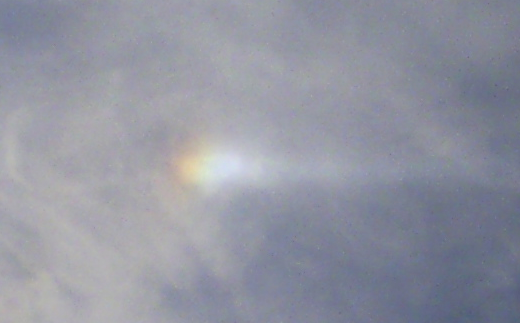 |
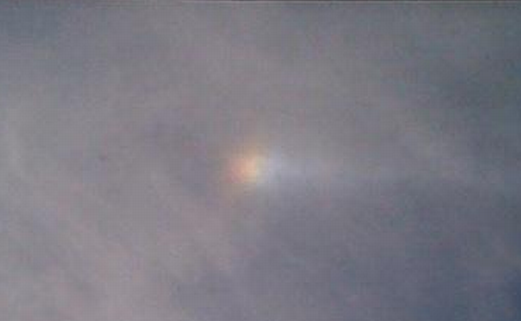 |
| Equalized perceptual luminosity |  |
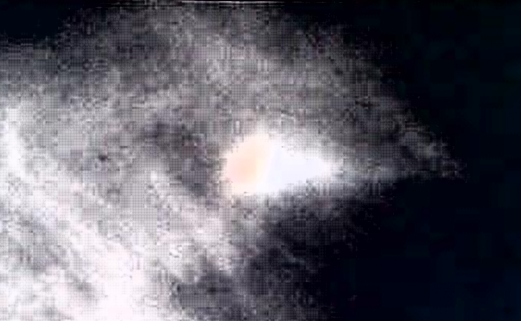 |
| Equalized and summed RGB channels | 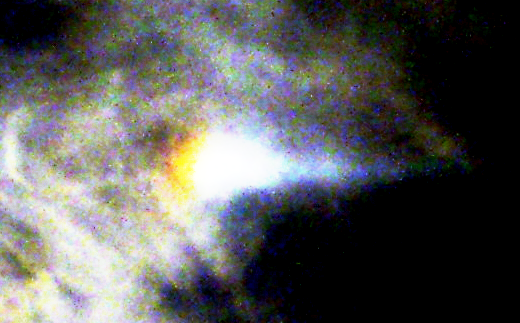 |
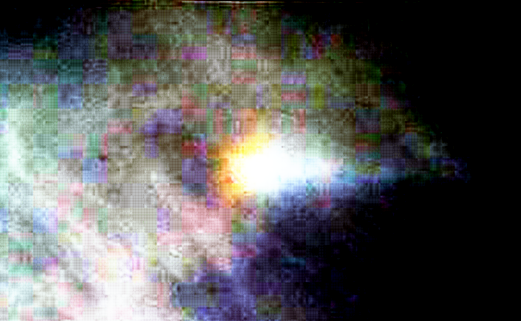 |
| Figure 2. Cropped images matched in size and position. | ||
The first column of Figure 2 shows that PhotoA contains an object that appears remarkably similar to some UFOs seen over the years. It has an inverted bowl shape that has often been reported. In the second row of the second column, the enhanced PhotoB also has a recognizable inverted bowl shape in approximately the same position but with a different orientation. Because of the lower resolution of the photograph, the shape is much less precise. At the very least, both photos independently indicate the presence of a solid object, perhaps a craft, beside the bright light.
The different orientations indicate that the presumed craft rotated in space during the time interval between the two photographs. From the position of the craft relative to the image borders, we see that the left edge of the craft remained stationary, while the right edge of the craft was tipped down about 45° in PhotoB relative to PhotoA. Therefore, the center of rotation was the extreme left edge of the craft. As noted earlier, the light appears to have moved sideways, but here we see that the craft itself only rotated. This means that the motion of the craft and the light are loosely coupled.
The origin of the light associated with the anomaly is not obvious. In the original PhotoA, the light seems to beam through the clouds towards the right. Figure 3 shows the object with the display gamma adjusted to reduce the visual masking of features due to the high brightness. This view indicates that the light has a toroidal structure seen almost edge-on. Further, the torus changes color according to the colors of the rainbow along its horizontal axis. Nearest the craft it appears red, then it progresses through orange, yellow and green, and finally ends in a bluish violet hue. It is as if a localized toroidal region of space adjacent to the object is refracting white light like a prism. The source of this light is likely the sun prominently displayed on the left of the original photograph.
But perhaps there is more going on in Figure 3. There is the suggestion of a subtle toroidal shape, also seen edge-on but perpendicular to the first torus. It appears to wrap around the first torus, overlaying the green band of color and continuing above and below it. The direct sunlight from the left is approximately normal to the plane of this torus, which might allow the torus to focus the light as if it were a lens. The light is then beamed further to the right where it is absorbed by clouds.
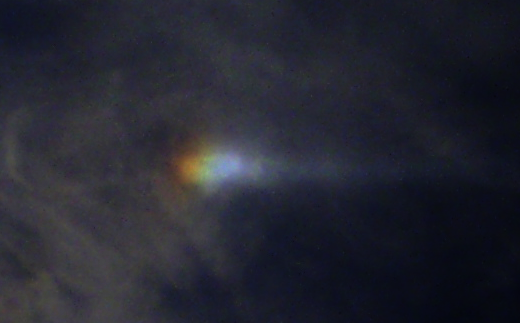 |
| Figure 3. Crop of PhotoA with reduced gamma. |
Not often do we have two different photographs of the same aerial anomaly. In this case, one photograph has twice the resolution of the other, and we can see clearly the importance of this parameter. The different sizes of the image encoding blocks is evident in the enhanced images of Figure 2. Likely for this reason, the shape of the object clearly seen in PhotoA is just barely recognizable in PhotoB. Nevertheless, the resolution is sufficient to show that the craft changed orientation and the light moved horizontally with respect to the clouds around it. That the object moved relative to the clouds is evidence that different forces were acting upon it. It was not just a cloud with unusual characteristics.
The object revealed by enhancing PhotoA is similar in shape to many UFOs photographed over the years. See here for samples of such photos. The presumed craft goes from a horizontal position in PhotoA to an angle of about 45° in PhotoB. These positions may be expected if the craft were executing a rocking motion often observed in UFO sightings. Paul Hill, in his book Unconventional Flying Objects: A Scientific Analysis, explains that such motion gives a disk-shaped object quick-acting control over altitude (p.164). So the different orientations in the two photos might be expected if the object were an intelligently controlled craft.
The craft pictured in the enhanced version of PhotoB is also quite similar in shape and orientation to another UFO photgraphed over Portugal on September 17, 2010, almost two weeks earlier. This photo, reproduced in Figure 4, was publicized in the March 2, 2011, Filer's Files news letter.
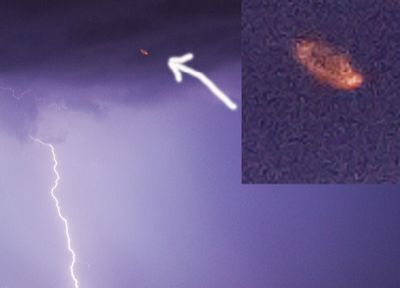 |
| Figure 4. A similar UFO photographed two weeks earlier, Courtesy of Filer's Files, #10-2011. |
A previous report suggested that the toroidal region of space often observed near a craft is a manifestation of the craft's propulsion system. Its visibility may be a side effect of a gravitational potential gradient generated by the craft, which organizes visible matter into a toroidal pattern. At any moment, the field would have an orientation appropriate for the craft's intended direction of movement. The observed loose coupling between the craft's position and the torus' position is in agreement with this hypothesis. Each new field gradient would be created at some distance from the craft's current position, so the distance between the craft and the nearest torus should vary as the craft moves from one generated gradient to the next.
The observation that localized regions near the craft appear to refract light confirms the conclusion of an earlier report based on a photograph also provided by Chris Malcheski. In that photo, a UFO was fortuitously positioned over a rainbow in the sky, and the pattern of rainbow colors passing through a toroidal region of space near the UFO was shifted spatially. In both cases, the presence of the UFO appears to have changed the index of refraction of an adjacent toroidal volume of space.